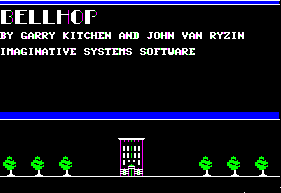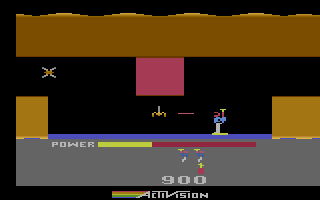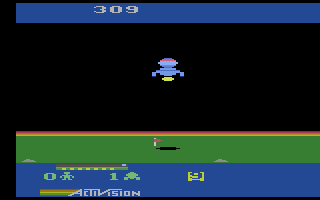

... John Van Ryzin
By Tim Duarte
New Jersey is famous for many things… Atlantic City, The Boardwalk, The New Jersey Devils hockey team, rock star Bruce Springsteen, the rock band Bon Jovi, etc. In the video game world, it’s also the home state of Digital Press. And did you know that a number of video game programmers are from New Jersey? I bet you thought they were all from California! Not so. I recently tracked down John Van Ryzin, probably best known in the classic gaming community for the Atari 2600. Here’s what we chatted about:
DP: How did you get into programming videogames? Did you study it in school?
John Van Ryzin: No, I went to school for Electrical Engineering. I was in a program where if you got a summer job that was related to your field, you could earn college credits. I ended up getting a summer job at a place that was making hand-held electronic games – the ones with LED lights on them. Then the Atari 2600 came out, and the company wanted to move from making the hand-held games to the Atari games.
DP: What company was that?
John Van Ryzin: That was Wickstead Design Associates.
DP: I’ve never heard of that company.
John Van Ryzin: This is the company that Garry Kitchen came from. I wasn’t creating 2600 games there; I was building prototypes of electronic toys. When I graduated from college, Garry Kitchen left Wickstead and started writing games for himself. So I started writing games on my own. He would get deals and sell them for me.

DP: Were these the Activision games you designed?
John Van Ryzin: No, these were games for the Apple II computer. I started out by buying an Apple II computer and I wrote a few games and they were published by Hayden Software. I did that for about a year, and then I was hired by Activision after that.
DP: Do you recall any of the names of the hand-held games you designed?
John Van Ryzin: I didn’t create any. I was just a “junior guy” who didn’t even have his degree yet. I just created these prototypes of wacky toy ideas that they had.
DP: For the Atari 2600, were H.E.R.O. and Cosmic Commuter the only games you did while at Activision?
John Van Ryzin: I worked on some others. But for games that were totally my work, those were the only two.
DP: When you were programming games for the 2600 at Activision, how much code sharing when on? The games seem to be based on the same graphics and scoring “engine” or style.
John Van Ryzin: There were a few basic things, such as the logo and the score, that were shared. But other than that, everything was written from scratch. There was a lot of sharing of ideas. For example, someone would figure out a trick how to do something and they would tell everyone else how it was done.
DP: Were the 2600 games written on the Apple II?
John Van Ryzin: No, those two games were written on a DEC PDP-11.
DP: What was the process of creating a game for the 2600?
John Van Ryzin: I would write the program on the PDP-11 and then compile the program. It was then transferred, or downloaded to a development system – a box that emulates an Atari 2600. The box had a joystick coming out of it, so I could sit there and play it. I didn’t have to burn a ROM. I could make changes to the program on the PDP-11, and transfer it to the box again for testing. Inside the box was a 2600, but a number of “tools” were connected to it. I could stop the game, and examine what was going on. I could de-bug my program.
DP: How does this development system compare to the ones for other systems you created games on?
John Van Ryzin: Well, on the Commodore 64, I would just program right on that machine. It was much more elaborate, though. A real simple development system would be where you’d just emulate the ROM – the chip that has the program in it. This is the easiest development system to create, but the hardest to use. There are no tools for looking for “bugs”. The development systems for the Genesis and Super Nintendo are very elaborate. They are similar to the Atari 2600 development system, where I can stop the program and examine registers, start the game again, etc. It makes it very easy to find bugs in the program.
DP: What about development systems for the Game Boy and Game Gear?
John Van Ryzin: Yes, they’re available.
DP: Do you have to buy development systems, or do you rent them?
John Van Ryzin: It varies. A programmer can buy one from Nintendo or Sega, or from third-party companies that create them. Or, you can create your own. Basically, the more elaborate the development system is, the more money it costs.

DP: HERO was one of the first games to feature a rainbow-style Activision logo on the screen. Were you responsible for creating this?
John Van Ryzin: No, that was created in the California office. I believe David Crane was responsible for that and he just passed it around for other programmers to put into their own games.
DP: Warren Robinett secretly hid his name within Adventure (by Atari). Are there any “Easter eggs” in any of your games?
John Van Ryzin: I never hid my initials or my name in any of my games. With all the companies I’ve ever worked with, I’ve been given credit for designing or porting or adapting almost every game I’ve ever done. I’ve never really felt any need to do that.
DP: Well, in Warren’s case, it was the late 1970s and the designers were not given credit. When you were with Activision, did you work from home as well?
John Van Ryzin: No, I worked in the New Jersey office.
DP: Do you work out of home for Absolute Entertainment?
John Van Ryzin: I freelance for Absolute. I was one of the founders of Absolute Entertainment. I worked there for a few years, left, and sold my ownership in the company. I’ve been doing stuff on my own ever since. However, I have done a lot of work for them independently.
DP: Are there classic games that you liked to play back then?
John Van Ryzin: Back then, my favorite game was Megamania (by Activision).
DP: Do you still have any classic systems?
John Van Ryzin: Yes, I have a pretty big collection. I have an Atari 7800 that I use once in a while. One of the perks of working for Activision was that when I first came there, they gave me every single game that the company made. While working there, every time a new game was released, I was given a free copy. All programmers had this “bonus”.
DP: Are you the programmer that beat all the Activision games and owns all the club patches? (Note: the HERO manual states John belongs to almost every Activision club.)
John Van Ryzin: I didn’t beat every one. The one that I got started on got me addicted to the whole videogame business was Skiing (by Activision). Years ago, at a local store, there was a contest for Skiing and Laser Blast (by Activision). I took part in that, went and bought Skiing and my brother and I would compete. It was really strange because I was really into it. And around a year later, all of a sudden I was working for Activision making games! This was strange, especially considering the company was in California and I was in New Jersey.
DP: That’s good timing…
John Van Ryzin: It was the whole thing with the part-time job while I was in college. I met all these people who were into hand-held games and they also wanted to get into videogames. One thing led to another…
DP: Do you have any favorite games on the newer systems?
John Van Ryzin: In my spare time, I like playing arcade games more than I like playing the home games. I’m at home programming the home games all day long. I like playing the arcade games because I feel like I’m getting some experience more than the home games. In the arcade, my favorite these days is the virtual racing game (Ed. Sega’s Virtua Racing). I can play that game all day long…
DP: By the end of the work day, do you find yourself so sick of videogames that you just want to turn everything off or do you find yourself playing games in your spare time?
John Van Ryzin: It depends. When I get to the end of a project, I work a lot of hours. It’s really intense. When I’m going through this phase, I really have no energy left towards it. Sometimes I just want to do something that doesn’t have anything to do with it – just to change my train of thought. Then, I come back fresh. But in a normal time period, I can work all day long and then go to the arcade at night with my nephew and play arcade games for a few hours. It has to be something different – as opposed to sitting in front of a game system, which I do all day long.
DP: Where there any other 2600 games that you did that were never released? There was talk about some unreleased games by Activision, and little is known about them. I’ve talked to some other Activision programmers… supposedly Zenji was going to be released. Do you know of any games that were close to completion, but where never released?

John Van Ryzin:
Yes, there was a lot of that. You’d be amazed by how much of that happened. In
the peak of the Atari 2600 days, Activision was very concerned about their
image. They would only release games that were really good. If a game didn’t
live up to their reputation, Activision had no desire to release it. Cosmic
Commuter is a perfect example. I finished that game in the peak of the industry,
when the 2600 was really hot stuff. Activision felt that it didn’t measure up.
They decided not to release it then. That was really disappointing for me – I
finally got a job with this big, successful company. I write a game, work like
crazy to do it, get to the end, and then they decide that they don’t want to
publish it! It probably took me nine months to write that game. So then I wrote
HERO. They thought HERO did measure up and they released it. Six months to a
year later, they decide to release Cosmic Commuter.
There were lots of games that the company was not thrilled with. Activision
opened up a number of design centers where all the people who worked there wrote
games. Then Activision would say that they didn’t like any of the games. Those
games were not released, and then the design center would be shut down. There
were some guys from the Boston design center that wrote a couple of games that
were pretty good, and Activision never released them. I only wrote two for the
2600.
DP: Did you have any ideas for games that never saw the light of day?
John Van Ryzin: I always have more ideas for games than finished games. It’s a lot easier to have an idea than to actually go through all the work to actually create a game.
DP: How are programming games today different than programming games when you first started?
John Van Ryzin: Today, I work on my own, but I really don’t. I have my own consulting company. I am capable of creating an entire game myself, but time-wise, it is impractical. I must have other people help me do it. I hire a consultant to do the music, a consultant to do some or most of the graphics, someone who writes the program with me… that kind of thing. In the “olden” days, I could do the whole game myself. I did this for a long time, even beyond the Atari 2600. You just can’t compete today in that way. With the complexity of the games, the amount of detail in the graphics, and the depth of sound effects and music in today’s games, there’s no way I could do it myself. I could, but it would take so long that by the time it was finished, that particular game system wouldn’t probably be selling.
DP: Have you programmed any games on the computer platforms – IBM or Macintosh?
John Van Ryzin: No, I haven’t. I’m interested in doing that, though. I find multimedia computers to be interesting.
DP: What are you doing now?
John Van Ryzin: I work out of my home and have my own consulting company called Panoramic Software. I am almost finished with an original game for the Super Nintendo and the Sega Genesis called Hellfire Run.
DP: What’s the process in receiving payment for creating a game?
John Van Ryzin: Basically, third-party companies hire me to create a game. They pay me an advance and royalties on the game.
DP: Was it like this 10 years ago?
John Van Ryzin: No, I was an employee and it was just a salary and a bonus.
DP: Where do you see the gaming industry heading five or ten years from now?
John Van Ryzin:
I think creating games is going to become more like a job of manipulating
databases that already exist. As I said before, when I create a game, I now hire
a musician and a graphic artist. I don’t see this being very realistic five
years from now. I think I’ll have to take existing information from something
else – for example, from a movie. I’ll be taking all the sound effects, film
clips, music, etc. and turning that into a game. Creating it from scratch at the
level games seem to be going towards will not be enough. The only people who
will be able to create the special effects that will be required in a game will
be the people in a movie studio. I won’t be able to create that stuff because
I’m not a Hollywood studio.
The virtual reality polygon world has a lot to offer, too. I could create a
virtual reality game myself by “purchasing” data, or objects to put into 3-D
worlds. Instead of creating the data, programmers will be acquiring it from
somewhere else…
| GAMEOLOGY |
| GAME | SYSTEM | COMPANY | STATUS |
|
Kamikaze |
Apple II | Hayden Software | released |
|
Shuttle Intercept |
Apple II | Hayden Software | released |
| Bellhop | Apple II | Hayden Software | released |
| Cosmic Commuter | Atari VCS/2600 | Activision | released |
| H.E.R.O. | Atari VCS/2600 | Activision | released |
| H.E.R.O. | Colecovision | Activision | released |
| The Complete Fireworks Construction Set | C-64 | Activision | released |
| X-15 Alpha Mission | C-64 | Activision | released |
| F-18 Hornet | C-64 | Absolute Entertainment | released |
| F-18 Hornet | Atari 7800 | Absolute Entertainment | released |
| Heavy Shreddin’ | NES | Parker Bros. (Imagineering) | released |
| Space Shuttle Project | NES | Absolute Entertainment | released |
| Race Drivin’ | SNES | Tengen | released |
| Steel Talons | SNES | Tengen | released |
| Hellfire Run | SNES | Panoramic Software | unreleased |
| Hellfire Run | Genesis | Panoramic Software | unreleased |
| Ren & Stimpy Veediots! | Game Boy | T*HQ | released |
| Super Battletank | Game Boy | Absolute Entertainment | released |
| Super Battletank | Game Gear | Absolute Entertainment | released |